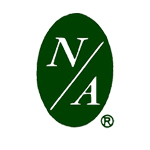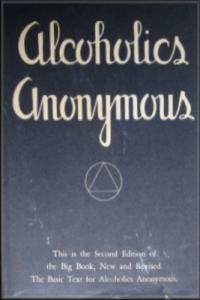
Alcoholics Anonymous (AA) is a global peer-led mutual aid fellowship begun in the United States dedicated to abstinence-based recovery from alcoholism through its spiritually inclined twelve-step program. AA's twelve traditions, besides stressing anonymity, establish it as non-professional, unaffiliated, non-denominational and apolitical with a public relations policy of attraction rather than promotion. In 2020 AA estimated a worldwide membership of over two million, with 75% of those in the US and Canada.
Twelve-step programs are international mutual aid programs supporting recovery from substance addictions, behavioral addictions and compulsions. Developed in the 1930s, the first twelve-step program, Alcoholics Anonymous (AA), founded by Bill Wilson and Bob Smith, aided its membership to overcome alcoholism. Since that time dozens of other organizations have been derived from AA's approach to address problems as varied as drug addiction, compulsive gambling, sex, and overeating. All twelve-step programs utilize a version of AA's suggested twelve steps first published in the 1939 book Alcoholics Anonymous: The Story of How More Than One Hundred Men Have Recovered from Alcoholism.

In psychology, codependency is a theory that attempts to explain imbalanced relationships where one person enables another person's self-destructive behavior such as addiction, poor mental health, immaturity, irresponsibility, or under-achievement.

William Griffith Wilson, also known as Bill Wilson or Bill W., was the co-founder of Alcoholics Anonymous (AA).
The Twelve Traditions of twelve-step programs provide guidelines for relationships between the twelve-step groups, members, other groups, the global fellowship, and society at large. Questions of finance, public relations, donations, and purpose are addressed in the traditions. They were originally written by Bill Wilson after the founding of the first twelve-step group, Alcoholics Anonymous (AA).

Cocaine Anonymous (CA) is a twelve-step program formed in 1982 for people who seek recovery from drug addiction. It is patterned very closely after Alcoholics Anonymous (AA), although the two groups are unaffiliated. While many CA members have been addicted to cocaine, crack, speed or similar substances, CA accepts all who desire freedom from "cocaine and all other mind-altering substances" as members.
Lois Wilson, also known as Lois W., was the co-founder of Al-Anon Family Groups, a 12-Step fellowship for the friends and family of alcoholics. She was the wife of Alcoholics Anonymous (AA) co-founder Bill W. They both followed their respective groups' tradition of anonymity until The New York Times revealed their full names upon Bill's death in 1971. However, she continued to be known as Lois W. within Al-Anon until her death.
Pagans in recovery is a phrase, which is frequently used within the recovery community, to describe the collective efforts of Neopagans as well as Indigenous, Hindu, Buddhist, and other like-minded groups, to achieve abstinence or the remission of compulsive/addictive behaviors through twelve-step programs and other programs, such as Alcoholics Anonymous, Narcotics Anonymous, Overeaters Anonymous, Al-Anon/Alateen, etc. These efforts generally focus on modifying or adapting the twelve steps to accommodate the Pagan world-view as well as creating Pagan-friendly twelve step meetings either as part of a preexisting twelve-step program or as independent entities.

Neurotics Anonymous (N/A), founded in 1964, is a twelve-step program for recovery from mental and emotional illness. To avoid confusion with Narcotics Anonymous (NA), Neurotics Anonymous is abbreviated N/A or NAIL.
Gamblers Anonymous (GA) is an international fellowship of people who have a compulsive gambling problem. They meet regularly to share their "experiences, strength and hope", so they can help each other solve the problems compulsive gambling has created in their lives, and to help others recover from the addiction of compulsive gambling. The only requirement for membership is a desire to stop gambling, as stated in the GA Combo book page 2.

Stepping Stones is the historic home of Alcoholics Anonymous co-founder Bill Wilson and his wife, co-founder of Al-Anon/Alateen Lois Wilson, in Bedford Hills, New York. The historic site features their house ; Bill W.'s writing studio, nicknamed "Wit's End"; approximately 15,000 objects left by the Wilsons; a water pump house; the original one-car garage; a two-car garage and Welcome Center with an orientation display highlighting some of the 100,000 items in the Stepping Stones Archives; a flower garden; a community vegetable garden; and more. Lois left the property to The Stepping Stones Foundation - the nonprofit, tax-exempt organization that she founded in 1979. Since Mrs. Wilson's death in 1988 the Stepping Stones Foundation has maintained and preserved the site with the help of friends, and has offered on-site tours by reservation and off-site educational programs.
Nicotine Anonymous (NicA) is a twelve-step program founded in 1982 for people desiring to quit smoking and live free of nicotine. As of July 2017, there are over 700 face-to-face meetings in 32 countries worldwide with the majority of these meetings occurring in the United States, Iran, India, Canada, Brazil, the United Kingdom, Australia, Russia and in various online community and social media platforms.. NicA maintains that total abstinence from nicotine is necessary for recovery. NicA defines abstinence as “a state that begins when all use of nicotine ceases.
Drug addiction recovery groups are voluntary associations of people who share a common desire to overcome their drug addiction. Different groups use different methods, ranging from completely secular to explicitly spiritual. Some programs may advocate a reduction in the use of drugs rather than outright abstention. One survey of members found active involvement in any addiction recovery group correlates with higher chances of maintaining sobriety. Although there is not a difference in whether group or individual therapy is better for the patient, studies show that any therapy increases positive outcomes for patients with substance use disorder. The survey found group participation increased when the individual members' beliefs matched those of their primary support group. Analysis of the survey results found a significant positive correlation between the religiosity of members and their participation in twelve-step programs and to a lesser level in non-religious SMART Recovery groups, the correlation factor being three times smaller for SMART Recovery than for twelve-step addiction recovery groups. Religiosity was inversely related to participation in Secular Organizations for Sobriety.

Alcoholics Anonymous (AA) is a global fellowship founded in 1935 by Bill Wilson and Robert Smith, and has since grown to be worldwide
Workaholics Anonymous (WA) is a twelve-step program founded circa 1983 for people identifying themselves as "powerless over compulsive work, worry, or activity" including, but not limited to, workaholics–including overworkers and those who suffer from unmanageable procrastination or work aversion. Anybody with a desire to stop working compulsively is welcome at a WA meeting. Unmanageability can include compulsive work in housework, hobbies, fitness, or volunteering as well as in paid work. Anyone with a problematic relationship with work is welcomed. Workaholics Anonymous is considered an effective program for those who need its help.
Families Anonymous (FA) is a twelve-step program for relatives and friends of addicts. FA was founded in 1971 by a group of parents in Southern California concerned with their children's substance abuse.
Survivors of Incest Anonymous (SIA) is a twelve-step fellowship for recovery from the consequences of childhood sexual abuse. SIA was founded in 1982 in Baltimore, Maryland by women who believed their experience in other twelve-step fellowships could assist in recovery from sexual trauma. In SIA incest is defined broadly as any sexual behavior imposed on one person by a member of his or her immediate or extended family. The extended family, in this definition, includes but is not limited to: grandparents, uncles, aunts, in-laws, clergy, teachers, cousins, family friends, and stepparents. The abuse may include verbal abuse, emotional abuse and physical behaviors; penetration is not necessary for meeting SIA's definition on incest. Covert incest within the family is also a theme many survivors explore in SIA.
Adult Children of Alcoholics founded circa 1973 is a fellowship of people who desire to recover from the effects of growing up in an alcoholic or otherwise dysfunctional family. ACA membership has few formal requirements. ACA does not accept any outside contributions and is supported entirely by donations from its members. The organization is not related to any particular religion and has no political affiliation. Tony A. was among its co-founders and is the author of The Laundry List, 12 steps for adult children of alcoholics, The Problem, which are all published in his book, The Laundry List: The ACOA Experience
The Calix Society is an organization in the United States founded in the 1940s which aims at addressing the particular spiritual needs of Catholics recovering from alcohol addiction, though it also ministers to those affected by other addictions. It affiliates closely with Alcoholics Anonymous, and believes in the effectiveness of the twelve-step program, but focuses on enabling Catholics who may have abandoned or neglected their faith during active alcoholism to return and have the fellowship of other Catholics in recovery. It promotes total abstinence for those in recovery, taking inspiration from Matt Talbot, and is concerned with the spiritual development and the sanctification of the whole personality of its members. The organization's motto is "substituting the cup that stupifies for the cup that sanctifies". The group has expanded since the 1940s to have active groups in 19 US states and in the UK.








